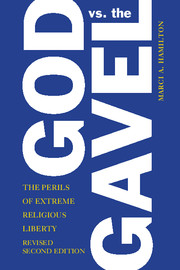Book contents
- Frontmatter
- Contents
- Acknowledgments
- Preface to the Second Edition
- Introduction: The Wages of RFRA
- Part One Religious Liberty is not a License to Harm Others
- Part Two The History and Doctrine Behind Common-Sense Religious Liberty
- 8 Ordered Liberty: Religious Liberty at the Supreme Court
- 9 The Decline of Church Autonomy and the Rise of the No-Harm Rule
- 10 The Path to the Public Good
- Epilogue: Follow the Money
- Foreword to the 2005 Edition
- Notes
- Index
8 - Ordered Liberty: Religious Liberty at the Supreme Court
Published online by Cambridge University Press: 05 November 2014
- Frontmatter
- Contents
- Acknowledgments
- Preface to the Second Edition
- Introduction: The Wages of RFRA
- Part One Religious Liberty is not a License to Harm Others
- Part Two The History and Doctrine Behind Common-Sense Religious Liberty
- 8 Ordered Liberty: Religious Liberty at the Supreme Court
- 9 The Decline of Church Autonomy and the Rise of the No-Harm Rule
- 10 The Path to the Public Good
- Epilogue: Follow the Money
- Foreword to the 2005 Edition
- Notes
- Index
Summary
The free exercise cases
The Supreme Court's consistent approach to free exercise has held that religious belief is absolutely protected, but religious conduct is subject to duly enacted laws. Why not follow the logic of libertarianism and extend the absolute freedom of belief to conduct? It is obvious. While beliefs harm no one, conduct can. In the words of Thomas Jefferson, “The legitimate powers of government extend to such acts only as are injurious to others. But it does me no injury for my neighbor to say there are twenty gods, or no God. It neither picks my pocket nor breaks my leg.”
This is a fundamental principle that unites the Free Speech and Free Exercise Clauses, and that rests on the republican form of government at the base of the constitutional order. John Stuart Mill explained it as follows: “The fact of living in society renders it indispensable that each should be bound to observe a certain line of conduct toward the rest.” Once one understands the no-harm rule and its distinguished pedigree, autonomy from the law for religious believers and organizations appears foolhardy.
- Type
- Chapter
- Information
- God vs. the GavelThe Perils of Extreme Religious Liberty, pp. 239 - 277Publisher: Cambridge University PressPrint publication year: 2014



